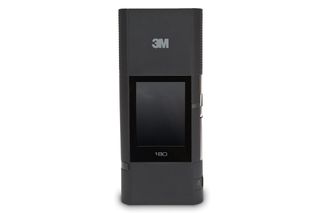IT Pro Verdict
It's commendable that 3M has gone further with the MP180 than any other pico projector before it, but the price reflects this. Given the unusable web browser, relatively poor image quality and whiny fan, Samsung's SP-H03 is still the better choice. It too has a built-in media player and a battery that lasts for two hours, but it also has slightly better image quality, it's more compact and is cheaper at around £200.

The 3M MP180 is considerably larger and heavier than most pocket projectors.

The bundled mini tripod isn't sturdy enough to keep the image still while you're poking the screen.

The 3M MP180 Pocket Projector
Pocket projectors are still a niche product, but are becoming more common. Manufacturers are beginning to integrate them into other devices such as cameras and camcorders, but they're little more than gimmicks. 3M's latest model - the chunky MP180 - hopes to appeal to the travelling presenter, and is the most feature-packed pico projector we've seen.
The most obvious extra is the colour LCD screen on the top of the unit. This 2.4in display makes a lot of sense as you can browse files stored in the 4GB of built-in memory as well as the contents of an inserted microSD card without needing to actually project an image.

The resistive touchscreen display requires a firm prod.
As it's a touchscreen, control is intuitive, but it wasn't quite as responsive as we've come to expect from modern capacitive screens - this is a resistive display which requires a firm prod. Occasionally the MP180's processing power appeared to be the weak link, as we were left waiting for menus to appear for several seconds after trying to exit an application.
The strangest built-in application is the web browser. This connects to the internet using the integrated Wi-Fi radio - websites are then displayed straight onto the nearest flat surface. Unfortunately, the browser looks like an ancient version of Internet Explorer. Entering a web address or Google search term is fiddly due to the tiny keyboard which appears on the 2.4in LCD screen. Trickier still is controlling the mouse pointer with the touchscreen - we found it almost impossible to be accurate. Worse still, you can't tap the screen anywhere to click; you have to prod a specific area at the bottom, requiring you to take your eyes off the projected screen to find it.